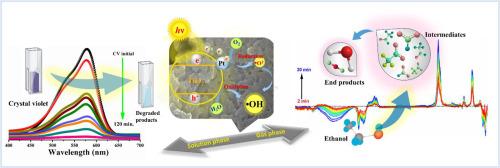Insights into the photocatalytic process of surface-platinized hierarchical anatase TiO2 nanoparticles by in-situ DRIFT analysis
IF 5.5
3区 工程技术
Q1 ENGINEERING, CHEMICAL
Journal of the Taiwan Institute of Chemical Engineers
Pub Date : 2024-10-18
DOI:10.1016/j.jtice.2024.105797
引用次数: 0
Abstract
Background
Environmental remediation researchers are challenged to unravel the mechanisms of dual-responsive photocatalysts for degrading pollutants in both liquid and gas phases. This study aims to provide comprehensive insights into the photocatalytic processes employed by surface-platinized hierarchical anatase TiO2 nanoparticles. The investigation includes an in-depth analysis of the associated mechanism through in-situ DRIFT analysis.
Methods
Utilizing surfactant-assisted surface platinized TiO2 samples synthesized through soft-template and chemical reduction techniques, this study investigated their efficacy in the degradation of crystal violet dye (10 ppm) under irradiation from a 380.8 W mercury-xenon lamp. The photooxidation of gas-phase ethanol was subsequently examined using the DRIFT technique.
Significant findings
The Pt-deposited C-TiO2 nanoparticles exhibited an impressive photocatalytic dye degradation efficiency of 87.07 %, surpassing the performance of other synthesized catalysts. To elucidate the mechanism behind this enhancement, an in-situ DRIFT analysis was conducted using the photo-oxidation of ethanol. The enhanced efficiency can be attributed to the incorporation of Pt metal, which serves as an electron collector in the n-type TiO2 semiconductor, thereby prolonging electron lifetime. Additionally, the pivotal role of hydroxyl radicals and holes in generating intermediates was thoroughly examined through DRIFT analysis, providing comprehensive insights into the photocatalytic reaction and the reactive intermediate species involved.

通过原位 DRIFT 分析深入了解表面铂化分层锐钛矿二氧化钛纳米粒子的光催化过程
背景环境修复研究人员面临着揭示双响应光催化剂降解液相和气相污染物机理的挑战。本研究旨在对表面铂化层状锐钛型二氧化钛纳米粒子的光催化过程提供全面的见解。本研究利用通过软模板和化学还原技术合成的表面活性剂辅助的表面铂化 TiO2 样品,研究了它们在 380.8 W 汞氙灯照射下降解水晶紫染料(10 ppm)的功效。重要发现铂沉积 C-TiO2 纳米粒子的染料光催化降解效率高达 87.07%,超过了其他合成催化剂。为了阐明这种提高背后的机理,利用乙醇的光氧化进行了原位 DRIFT 分析。效率的提高可归因于铂金属的加入,铂金属在 n 型二氧化钛半导体中起到了电子收集器的作用,从而延长了电子的寿命。此外,还通过 DRIFT 分析深入研究了羟基自由基和空穴在生成中间产物过程中的关键作用,从而全面揭示了光催化反应及其所涉及的活性中间物种。
本文章由计算机程序翻译,如有差异,请以英文原文为准。
求助全文
约1分钟内获得全文
求助全文
来源期刊
CiteScore
9.10
自引率
14.00%
发文量
362
审稿时长
35 days
期刊介绍:
Journal of the Taiwan Institute of Chemical Engineers (formerly known as Journal of the Chinese Institute of Chemical Engineers) publishes original works, from fundamental principles to practical applications, in the broad field of chemical engineering with special focus on three aspects: Chemical and Biomolecular Science and Technology, Energy and Environmental Science and Technology, and Materials Science and Technology. Authors should choose for their manuscript an appropriate aspect section and a few related classifications when submitting to the journal online.

 求助内容:
求助内容: 应助结果提醒方式:
应助结果提醒方式:


